Played on Windows
Also Available on Xbox One, PlayStation 4
Disclosure (review copy) at the end.
I heard a lot about Hellblade: Senua’s Sacrifice and its treatment of mental illness. Now everyone talks about this with Hellblade and I feel mental illness is an important topic. I both advocate for destigmatizing it, and treatment of it, but I also really get nervous when pop culture talks about it because the fact is people treat the topic of Mental Illness as a story element and not a deeper topic. So when I approached Hellblade: Senua’s Sacrifice I was nervous.
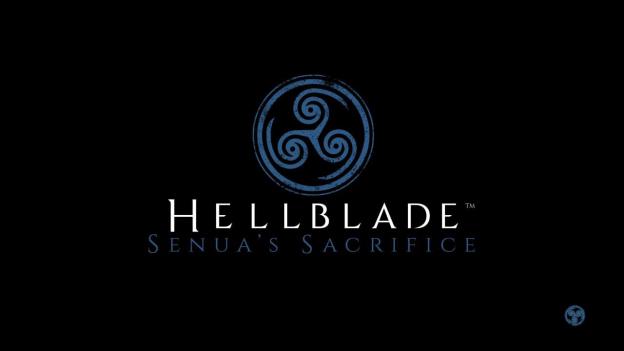
The fact is I don’t feel that I have a right or at least a proper knowledge and background with mental illness or psychosis to discuss that angle of this game, and a lot of people have talked about Hellblade in that way, at least some of them should be more qualified for that discussion. I do feel it’s well covered and done by professionals in the mental health field that I will sidestep that, but I will delve into the story and how it deals with many of these issues because as a game reviewer that’s what I do.
Now I’m going to give a big spoiler warning. The ONLY way I feel I can properly review Senua’s Sacrifice is by diving deep down into the game and really talking about almost every part of the game. This means I will have to give a lot of spoilers, and I need to discuss the final areas and the bosses. It’s just how Hellblade is developed that I only feel right in discussing everything.
But I also believe this is a game that players should experience fresh, and not be spoiled. As such, I’m going to do something different in this review, because Hellblade: Senua’s Sacrifice is such a special game with a major focus on story, and it’s worth playing I’m going to give a score at the beginning and so you can judge Hellblade based on that, hopefully, play it and hopefully one day return to see my opinion.
Hellblade: Senua’s Sacrifice gets a
4.5/5
It’s almost a perfect game and well worth the price of admission. If you want to check it out, please go play it and don’t let anyone spoil the experience. I have a first look that spoils almost nothing check it out if you’re curious.
That was for the people who only wanted the score and the first look out of the way. Now, let’s begin with the beginning of Hellblade
Hellblade: Senua’s Sacrifice is a Norse story, involving a woman named Senua as she travels to Helheim. This relies on the same legends as the Marvel movie Thor, and now the mythology that Kratos from the recent God of War(2018) is now murdering his way through.
I’m going to give a rather long recounting of the story here. This isn’t the ENTIRE story, however, it is many of the major events that happen to her, the reason I am doing this is that the story should give context for the rest of the review.
Hellblade starts with Senua already on her quest to Helheim. We’re not greeted by Senua but rather a long opening where we are told about Senua’s quest by a guiding voice. It’s not one Senua openly acknowledges often but the one who talks directly to the player informing him of the story and important facts. Senua is on a wooden log, used almost as a canoe, as the back story is imparted to the player.
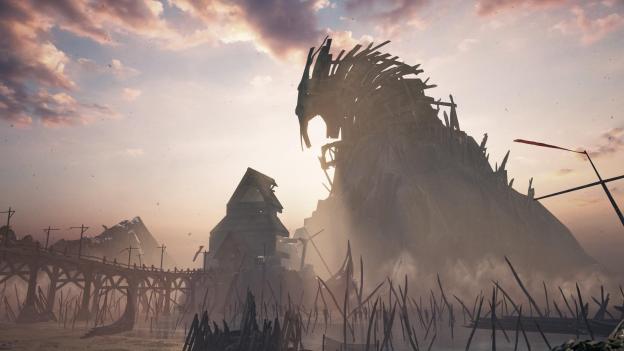
Helheim, Land of Death. Beautiful or horrifying?
In addition, there are also the “Furies” as they are listed in the credits of Hellblade. A set of voices who gives us our first really impressive connection to psychosis. For the entire game these Furies will talk and try to impart information but often give conflicting accounts in short bursts. It brings the viewer into Senua’s head, where the player now will constantly be pestered by these voices, almost unable to focus on what’s important due to their noise.
Senua finally reaches a shore and we start to see her react to the voices, it’s a rare occurrence and as such it’s powerful because, for the most part of Hellblade, we observe Senua, though see the game alongside the voices that she must always hear. In fact, the experience is quite well done because Senua becomes vulnerable. We not only see her story, but we experience it. We see her suffer, we see her pain, and we see her fears play out through Hellblade, and each step of the way, I felt a bond forming with her.
The player will walk on for about thirty minutes through areas and gets started with a small piece of combat in front of a large door with Hel’s face on the front. Hel is the ruler of Helheim and we learn that Senua came to get her beloved “Dillion” back from Hel. The collective “we” of all her voices are joined by a new friend that we meet called Druth, a friend of Senua. He joins the choir just as each voice must have before him. He fills in much of the story of the world outside of Senua’s experiences, and the Celtic and wilderness life that Senua also must have some knowledge of.
There are also a number of signposts throughout Hellblade that offers the player a chance to hear some of the tales of Norse mythology, and these are particularly good. I enjoyed almost every story, although it’s a little bit of a shame that you have to stick close to some of these posts. Still, they are entertaining and the stories are exciting. There are tales of Fafnir, Ragnarok, the entire Ring cycle that Wagner adapted for his famous operas, and quite a few other stories. I always looked for these because I was just fascinated by the storytelling.
So when the door to Helheim is found, we know we have to go defeat two gods. There’s Valravn the god of illusions and Surt the god of fire. Both of these areas are interesting and unique. Valravn plays with your mind with illusionary puzzles and Surt develops into pathfinding puzzles while the world is on fire. Both are interesting and unique experiences, but they both only take about an hour apiece. Still, they are very interesting experiences but in these areas, the story is a little light in my opinion.
However, the character development is on point. You see the furies are always with Senua, and they continue to make their presence known. There’s a point where I was having trouble and Hellblade taunts me with one of the voices saying “You’re stupid” and I was like “shit that’s not nice” but at the same time, I imagined hearing that often when I doubted myself. Sometimes I do feel like a world is silently judging me, but to actually hear it being thrown at you hurt just a bit, and again I empathize with Senua. It’s a powerful moment that I only thought about later.
There are other points where the furies show up, like a line of thoughts with Valravn’s evil illusions where you hear “It’s a trick” “Who’s helping her?” “No one” “Someone”. The voices in Hellblade aren’t just assisting the player. I almost felt like I had an audience. I wasn’t playing a single player game, instead, I was playing a game on a stage in front of a crowd of people and they all were talking about it at the same time. The discussion aspects really worked to bring me into the world.
Hellblade hides most of the backstory about what happened to Dillion until about the halfway point and then it starts to discuss more of its story and expand on it. We start to see Dillion and Senua’s meeting and get pieces of their backstory together. It’s more of a feeling of starting to understand Senua as a character to see what happened to her in the past, and it’s very effective.
Hellblade moves on and we start to meet what is known as “The Beast” also representing the darkness, and again another powerful section is presented. After fighting the boss, we start to realize what the Darkness is to Senua. It’s not completely spelled out but it’s quite clear that the Darkness we’ve seen the entire game is actually Senua’s father. We also learn quite a bit more about the backstory, learning again what led up to this point and, in fact, that one connection starts to put the entire game into the proper perspective.
Then Hellblade comes to an end, with the final confrontation with Hel, and the game resolves itself. The fact is the game’s ending can be quite confusing, but it’s not left to interpretation. It’s pretty clear what happened, and the fact is it’s an interesting ending for a story.
So as a sum total, I can say everything in Hellblade’s story was done well, the delivery of backstory comes at a point where it’s necessary, but doesn’t take away from the gameplay. The revelations about what has happened in the past is powerful and needed, and as mentioned the bond between player and Senua’s character is continually strengthened, not just through her pain, though that is used effectively while you play, but also through learning about her weakness, her backstory, her life. You feel for Senua because you experience it in the third person and constantly feel like you are one of the voices in her head.
In game, the player controls Senua but Hellblade continues to talk to you as if you are just one of her many voices, and that move really allowed me to feel the story flow through me and I became a part of the story instead of feeling like I was being lectured by a piece of media and a writer’s desire for exposition.
If I was grading Hellblade based only on the story, or if this was a book or a movie, this would be a near perfect story, it’s impressively done and so well executed I feel that I have to point out many of the elements in the story because they are all so effective. Though I’ve left a number of the elements out.
At the same time, after playing for about thirty minutes, I had to go back and replay Hellblade for a few screenshots, and I started to notice small little touches the game has in the story. Words used that feel like they are chosen at random have deeper or different meanings. There’s so much richness to the writing that assists the story, that I have to call it out as well.
The graphics too help tie the story together. Senua looks incredible, and there’s so much detail in her graphics and character. She’s an interesting character, but the animation work and acting really help make her a great character. Hellblade does something odd, and often shows Senua talking to the camera, but the entire acting and experience is done so well and wonderful that it is never a problem or distracting, you’re wrapped into the moment and experience of Senua that while she spikes the camera constantly and has a conversation with it, all you can feel is the power of those moments.
Senua doesn’t just look at you, she looks into your soul, and shatters the fourth wall, but then replaces it when she looks away and then continues her monologues with amazing delivery. It’s honestly extremely well done. It’s a violation of everything that people do with camera work and yet it still is exceptionally powerful.
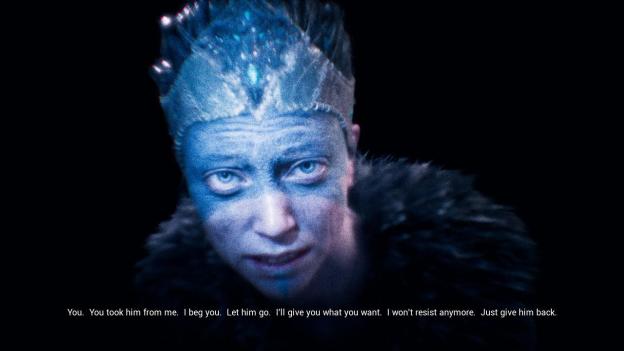
She doesn’t just glance. She demolishes that wall at times.
And the sound. I don’t normally talk about sound because most games… well, are typical with sound. Yeah, there’s some unrelated music or some dialogue that someone mixed well and it works but there’s nothing much to say other than “good soundtrack”.
Hellblade made me understand why sound design is important with video games, you can hear me gush over the sound in the first look, and I’ll admit the first look has only stereo because that’s what my Nvidia’s shadowplay captures. It’s so much better than that though. Hellblade mastered sound design and show it in almost every scene. The furies and the narrator’s voice don’t just talk to you or don’t just come from one direction, but they surround you. The first lines of dialogue are spoken as the voice moves around you and tickles your neck. It’s an incredible experience. The furies’ voices come as that audience I mention but they also are all around you, coming from the left right, back and so on. The action is mostly from the front of your view but every direction is filled to create a soundscape and it’s incredible.
I love the story of Hellblade. The graphics are great. But the sound design make both of them look weak because this feels like a course on why audio design is important. I’m only sad because no other game in a very long time has felt like it’s done anything even close to this level of work, because this is pure mastery of the form.
Hellblade would be a very good game without the work done on the audio, but with it… I was completely stunned to the point of feeling I couldn’t talk over it in the First Look because I was enjoying the moment so much. I had to pause Hellblade to even discuss the moment because I wanted to give it the floor, and I didn’t want you to miss a moment of the experience.
Honestly, if you play Hellblade, I highly recommend you play with headphones, even a weak pain will really enhance the experience. A 5.1 surround system would work too. It’s just an amazing experience you don’t want to miss. There are subtitles, but subtitles are only good for the story, there’s an entire experience that Hellblade delivers that needs to be heard to really enjoy.
So going back to the theme of psychosis. Not every discussion or audio clip is useful. There’s a moment where I got hit by an attack and a voice shouted: “There’s blood?” It was distracting, odd, unique and really made me enjoy the game. Over time I learned to start trusting the voices. They became an effective way for me to fight because they would warn me about something, such as an enemy behind me, or that I need to use the mirror ability. They are distracting but at the same time helpful, it’s a rather clever system to add something new to gameplay through the audio cues, and yet still develop the character more with them.
Though I have to say by the end of Hellblade some of the tricks used to make the voices shine did get a little repetitive. They are a solid experience for most of the game, but they did start to get on my nerves in a couple ways by the end. Nothing specific and perhaps that’s also intentional but overall the audio design of this game is incredible.
So all that’s left is gameplay, with a great story, great audio, and great graphics, gameplay must be amazing right?
Well no. I am a firm believer in “Gameplay is King” and by that, I mean the gameplay is the most important piece of a game, and everything should be in service to the gameplay and experience of playing the game.
Hellblade doesn’t believe in that. I can’t tell you for sure, but I believe Hellblade places the story at the top of the crown and just pushes that angle for everything it does. It actually does quite a bit for the gameplay that I have issues with. There’s no tutorial, there’s no real ramp up and honestly, the difficulty curve is all over the place but mostly non-existent, the puzzles in the game are rather simplistic. In fact, if I was to pull away all the pieces, I could make a strong case that Hellblade is a glorified walking simulator. That’s actually a comparison I thought about a bit, and I think it’s true.
But at the same time, Hellblade somehow makes me accept those faults. Yes, there’s no tutorial, but understanding combat is the point of the combat. The gameplay doesn’t evolve but instead it stagnates and feels dull and repetitive for most of the game, and maybe part of that could be related to the story elements. Her psychosis is giving her enemies to fight. The puzzles are really simple, but again, is it an accident or is it a meaningless fetch quest because of her illness.
The combat is the biggest problem I have with Hellblade. Hellblade doesn’t have a very deep combat system. I’d argue this is still slightly better than Enslaved’s combat, but I have to be honest about it and I feel the combat becomes dull and repetitive. There are maybe six enemies that you see over and over. I might be forgetting a couple, but there’s probably 10 counting the bosses. Eventually, there were points where you walked into an obvious arena and I thought “damn” because I didn’t feel like fighting.
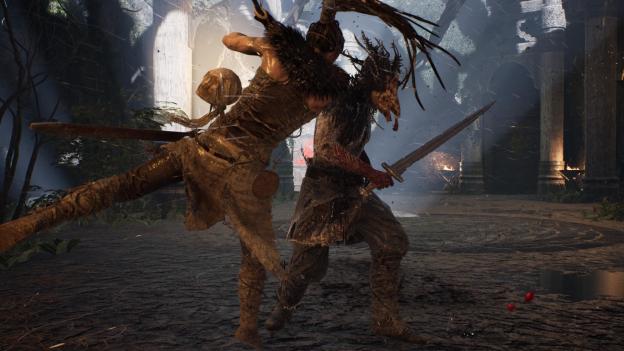
A riposte, looks great but it becomes the only attack you’ll use.
The only enemy that gave me trouble was the shield fighter, and eventually, I figured out I had to use melee attacks. There was no tutorial about it, and the voices didn’t seem to help me figure it out. If it wasn’t for the pause screen I wouldn’t even know I could use melee, but I felt good when I did figure it out, after a few really hard encounters with the enemy.
At the same time, the lack of a tutorial is a bit of a shame and could have helped flesh out the combat a bit more. And again, I wonder if this is intentional in the service of the story or not, but the experience isn’t fun. For a game that’s a masterwork of storytelling, they could have made the combat “feel” dull to the character, without making it so to the player.
There are also only three bosses. Valrayn, Surt, and the Beast, who is Fenrir. Each boss feels unique and different and I rather enjoyed Valrayn and Fenrir especially but the first two bosses happen in the first two hours of gameplay, Fenrir happens around hour 7, for an 8-hour game, that’s awful pacing for the combat. Still, there’s a huge part of the game that combat doesn’t exist in and that walking simulator comparison becomes stronger.
Did you notice a name not mentioned in the boss list? Hel. The entire game builds to a meeting between Senua and Hel, and instead, you get three arena’s as a final battle, and it’s not even arenas you can lose. This is clearly in service of the story, but damn it, it’s not a very enjoyable moment when the game is over because instead of a culmination of the gameplay, you get a culmination of the story, and the ending feels… missing. That final moment, that release of the game, I felt it with the story, but my combat instincts were screaming for one last fight which the game refused to give me.
There are some good points, though, to the combat. There’s an auto combat difficulty that I used. I don’t know where I ended up, so honestly, I can’t judge the combat on its difficulty, but I rarely was challenged. Maybe the combat is easy, or maybe I never got that high up the scale, but overall, I just wanted more meat to the combat.
Puzzles too in Hellblade are somewhat weak. Many of them are perspective puzzles and you walk around a medium sized area and find what you are looking for. But … I wanted more. The puzzles work in service of the story, but they feel too much like a simple walking simulator instead of being a grand adventure and again, my gameplay spirit wanted more, while my desire for the story told it to wait in a corner.
A few puzzles are “get it or don’t” moments, and I even had to look up two solutions because I didn’t get it. There also was a moment where the game promised me “Valrayn’s song will guide me” it worked until it didn’t.
Still, there are a few choices that are rather solid here. There’s no hud, and no health bar, in fact, there’s a knockdown before death, and it was easy to come back from it in most battles, the furies helping in combat was amazing, and the simplicity of the combat could be good if there was just a little more depth.
So let’s talk a little more about problems. In my first look, I play up to the point where the game says “The game will delete if you die too much.” I didn’t really test it but… The darkness it says will grow and kill me, seems to be a story element, not a gameplay feature. At the same time, it is presented as a gameplay feature, not a story element. Is it another moment in service of the story? Perhaps, to put players on edge… but it’s such a shitty moment, honestly. I believe that’s their intended use, but it’s done in the absolute worst way. You lie to the gamer about a major system to make him feel uneasy, but instead of it being told in the story, it’s one of the only tutorial messages. Imagine if Dark Souls said “this game has permadeath” at the beginning, not in a bloodstain text but in a help text message to the audience. It’s untrue and some people would love it, but lying to the audience could have been done better. It’s a big fail in my opinion.
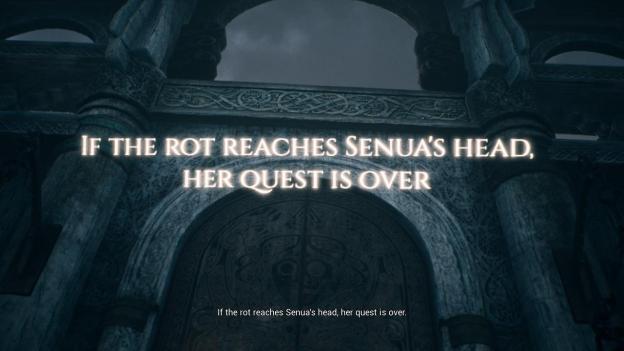
Lies, but effective ones. If this wasn’t the only in game text like this maybe it could have worked better.
I mentioned missing a path due to no song in the Valrayn area. I love this area, I think it’s the best part of the game, but overall it’s a bit tricky and I wandered around for about 10 minutes going “Where am I?” Finally looking it up.
The amazing Norse mythology on the posts is great. Except if you don’t hear all the stories about a specific topic you don’t get the ending to that story. And you can’t go back, there’s no chapter select or anything, instead, you have to start the game from the beginning and hit them all. I wanted to hear them all but not enough to play the entire 8-hour game again specifically for that.
Those story posts lead to the alternate ending, and someone told me what it was. It’s a major plot point and I think it’s critical to the story. I didn’t get it though. A real shame, because I think it really defines an important character and changes a piece of the story that’s really essential to understanding the character at a deeper level.
There is also a lot of “just walking” in this game as well. Great if you want that, but if that’s the point of the game, less combat would have been better, not more.
There’s also a small graphical animation glitch when you die and you can get reborn and move around before your body properly animates, a very minor and probably petty glitch, but still something I noticed the few times I died. In addition, sometimes while you’re walking through an area, Senua speaks to a fury, to Druth, or herself, and the game doesn’t do any attempt at lip syncing. It is again a minor issue but the animation and lip sync is so amazing in the game, that it’s noticeable when it drops the ball in these moments.
Finally, let’s talk about mental health and psychosis. Again I’m not trained enough to really talk about it, but the game does a good job with the topic. The game leaves the story in an odd place. I like the ending in the game but it’s a bit sudden. In fact, it’s set up to have a really solid and interesting ending. This is a game that doesn’t talk about psychosis but rather attempts to illustrate psychosis and it does a good job from what I understand.
I don’t want to say “There is a better story” but there’s a possibility of one. You see when you “beat” Hel without fighting her, you find out that Senua decides to come to grips with Dillion’s death and listen to the voices in her head. It’s an interesting moment and good. The problem is the game kind of cheats and doesn’t earn the ending. It’s a sudden change in Senua, and while you see her come to grips with Dillion’s death, you don’t see the illness really fighting her, you just see in-game combat.
A better solution could have been that the game takes the voices away and you start to realize how hard combat is without the voices, and it would be since you rely on them for most of the game. Senua and you both realize that Senua can’t survive without them, that not only are they terrorizing her but they are assisting her as well. It’s clear that’s a thought of the game, at least the player is getting a lot of help from the voices.
If the game added in a little gameplay element it could have made the player feel more accomplished. Instead, the game ends on a “can’t win battle” where you don’t even fight the boss you are promised in the game. The story tells of her “beating” her psychosis, or at least coming to terms with it, but the player is left unsatisfied because her psychosis isn’t overcome, or defeated by him, the story just says “I beat it” and leaves the player in an interactive medium to realize that he didn’t beat it and it’s a feeling that he’s cheated. The transition of Senua’s character is complete but the player can feel like he was only along for the ride, and wasn’t a major part in the real battle of the game, of her mental illness.
I like the story a lot here, but the problem is the gameplay doesn’t rise to the occasion often enough to support the ending or much of the story here. It’s a shame because there are three tent poles of a VERY strong game here, but the gameplay lets the game down just enough to be really noticeable.
So yeah, there’s quite a bit that I have an issue with, and ultimately, I look at the review this way. There are three views I have of this game. If you want a heavy and deep story with a very little combat and action, this game is perfect. I mean it’s really fantastic, and probably perfect for that. But at the same time, if you want a great action game, this isn’t it. I don’t think it’s something I can’t recommend if you want to enjoy combat and don’t care for the story. So as a review I realize that I can’t call Hellblade perfect, but I adore so much in this game, and while the combat is flawed, and the puzzles are weak, I think at the end of the day, the story is so blazingly strong, the audio design is so phenomenally good, and the delivery of the entire experience is so solid, that this isn’t just a recommendation or only a strong recommendation. There’s only one review score I can really give this game…
4.5/5
It’s flawed, but only slightly. I loved almost every minute of this game, and even the slightly underwhelming combat couldn’t hurt my total enjoyment of the story. I came for an action game, and I ended up with a story based game, and yet I think this is one of the strongest stories and experiences that the gaming industry has produced in a long time.
After finishing playing Hellblade Senua’s Sacrifice and writing the review, I looked around at other opinions of it, to make sure I didn’t miss something obvious or if anyone agrees. There was one problem I noticed. I didn’t see Hellblade on many best-of lists last year, and that’s a crime. Maybe it was forgotten, or maybe it’s smaller studio, smaller price, or it just didn’t resonate with reviewers. Well, that’s a shame because it’s one of the strongest experiences I’ve had in gaming, and it deserves more attention. Personally, I hope I’ve done it justice.
Final thoughts: Starring an amazingly strong story, graphics, and art design, Hellblade shouldn’t be missed. However, the gameplay will drag this game away from perfection, but not far enough to be ignored.
Stats: 8.6 hours 13/14 achievements
Disclosure: I requested a review copy from Ninja Theory, as my first review on this site was Enslaved, also by them. They gave me a free copy to review. I thank them for this, however, this did not affect my review.
